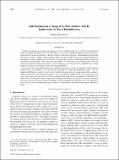Self-Stratification of Tropical Cyclone Outflow. Part II: Implications for Storm Intensification
Author(s)
Emanuel, Kerry Andrew
DownloadEmanuel-2012-Self-Stratification.pdf (664.9Kb)
PUBLISHER_POLICY
Publisher Policy
Article is made available in accordance with the publisher's policy and may be subject to US copyright law. Please refer to the publisher's site for terms of use.
Terms of use
Metadata
Show full item recordAbstract
Tropical cyclones intensify and are maintained by surface enthalpy fluxes that result from the thermodynamics disequilibrium that exists between the tropical oceans and atmosphere. While this general result has been known for at least a half century, the detailed nature of feedbacks between thermodynamic and dynamic processes in tropical cyclones remains poorly understood. In particular, the spatial relationship between surface fluxes and the radial entropy distribution apparently does not act to amplify the entropy gradient and therefore the surface winds. In previous work, this problem was addressed by accounting for the radial distribution of convective fluxes of entropy out of the boundary layer; this led to the conclusion that a radial gradient of such convective fluxes is necessary for intensification.
Part I showed that the assumption of constant outflow temperature is incorrect and argued that the thermal stratification of the outflow is set by small-scale turbulence that limits the Richardson number. The assumption of Richardson number criticality of the outflow allows one to derive an equation for the variation of outflow temperature with angular momentum; this in turn leads to predictions of vortex structure and intensity that agree well with tropical cyclones simulated using a full-physics axisymmetric model. Here it is shown that the variation of outflow temperature with angular momentum also permits the vortex to intensify with time even in the absence of radial gradients of entrainment into the boundary layer. An equation is derived for the rate of intensity change and compared to simple models and to simulations using a full-physics model.
Date issued
2012-03Department
Massachusetts Institute of Technology. Department of Earth, Atmospheric, and Planetary Sciences; Massachusetts Institute of Technology. Program in Atmospheres, Oceans, and ClimateJournal
Journal of the Atmospheric Sciences
Publisher
American Meteorological Society
Citation
Emanuel, Kerry. “Self-Stratification of Tropical Cyclone Outflow. Part II: Implications for Storm Intensification.” Journal of the Atmospheric Sciences 69.3 (2012): 988–996. © 2012 American Meteorological Society
Version: Final published version
ISSN
0022-4928
1520-0469